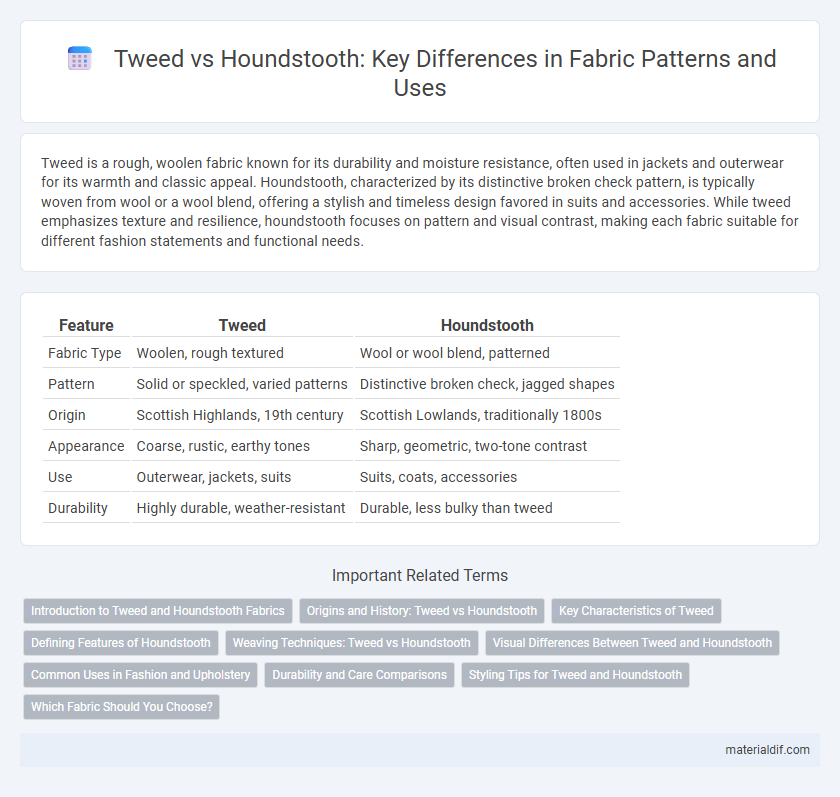Tweed is a rough, woolen fabric known for its durability and moisture resistance, often used in jackets and outerwear for its warmth and classic appeal. Houndstooth, characterized by its distinctive broken check pattern, is typically woven from wool or a wool blend, offering a stylish and timeless design favored in suits and accessories. While tweed emphasizes texture and resilience, houndstooth focuses on pattern and visual contrast, making each fabric suitable for different fashion statements and functional needs.
Table of Comparison
| Feature | Tweed | Houndstooth |
|---|---|---|
| Fabric Type | Woolen, rough textured | Wool or wool blend, patterned |
| Pattern | Solid or speckled, varied patterns | Distinctive broken check, jagged shapes |
| Origin | Scottish Highlands, 19th century | Scottish Lowlands, traditionally 1800s |
| Appearance | Coarse, rustic, earthy tones | Sharp, geometric, two-tone contrast |
| Use | Outerwear, jackets, suits | Suits, coats, accessories |
| Durability | Highly durable, weather-resistant | Durable, less bulky than tweed |
Introduction to Tweed and Houndstooth Fabrics
Tweed is a rough, woolen fabric known for its durability and moisture resistance, traditionally used in outdoor and country wear. Houndstooth features a distinctive broken check pattern, often woven from wool, creating a visually striking textile used in tailored garments. Both fabrics share a heritage in British fashion but serve different aesthetic and functional purposes.
Origins and History: Tweed vs Houndstooth
Tweed originated in Scotland during the 18th century, renowned for its durability and suitability for outdoor activities, while houndstooth emerged in the Scottish Lowlands as a woven textile pattern featuring broken checks. Tweed's heritage is deeply rooted in rural estates and hunting traditions, contrasting with houndstooth's association with traditional Scottish weaving techniques and distinct visual pattern. Both fabrics have evolved from practical beginnings into iconic fashion statements, symbolizing different aspects of Scottish textile history.
Key Characteristics of Tweed
Tweed fabric is characterized by its rough, woolen texture, dense weave, and excellent durability, making it ideal for outerwear and cold-weather garments. It often features a subtle mix of colored threads, creating a muted, earthy tone, and commonly includes patterns like herringbone or twill. Tweed's moisture-resistant properties and insulating capabilities distinguish it from lighter, patterned fabrics like houndstooth.
Defining Features of Houndstooth
Houndstooth fabric is characterized by its distinctive broken check pattern made up of abstract four-pointed shapes, often in contrasting black and white or other colors, creating a jagged, tessellated effect. Unlike the more textured and heavier weave of tweed, houndstooth features a tighter, smoother weave with sharper geometric clarity. This pattern originated in Scottish textile design and remains popular in fashion for its bold, classic visual impact.
Weaving Techniques: Tweed vs Houndstooth
Tweed is a rough, woolen fabric characterized by a plain, twill, or herringbone weave, offering durability and warmth with its tightly woven fibers. Houndstooth features a distinctive broken check pattern created through a unique weaving technique combining alternating colored threads in a four-pointed jagged design. The weaving process for tweed emphasizes texture and robustness, while houndstooth prioritizes precise pattern definition and contrast in its weave structure.
Visual Differences Between Tweed and Houndstooth
Tweed features a rough, irregular texture with a mix of earthy colors and often displays a twill or plain weave pattern, giving it a more rustic and rugged appearance. Houndstooth is characterized by its distinct broken check pattern, typically in black and white, forming a sharp, jagged four-pointed shape that creates a bold, graphic visual contrast. The key visual difference lies in Tweed's textured, multicolored look versus Houndstooth's clean, repetitive geometric motif.
Common Uses in Fashion and Upholstery
Tweed is widely utilized in fashion for structured outerwear, such as jackets and coats, as well as in upholstery for its durability and classic texture. Houndstooth, characterized by its distinctive broken check pattern, is popular in suits, skirts, and scarves, often adding a sophisticated, bold statement in fashion, while in upholstery it provides a visually striking yet traditional look. Both fabrics are prized for their versatility, but tweed's ruggedness suits rustic and casual styles, whereas houndstooth is favored for more formal and high-fashion applications.
Durability and Care Comparisons
Tweed is renowned for its exceptional durability due to its thick, tightly woven wool fibers, making it highly resistant to wear and ideal for outerwear. Houndstooth, while also durable, features a lighter weave that demands more delicate care to maintain its pattern and avoid fraying. Proper maintenance of tweed involves regular brushing and airing, whereas houndstooth fabrics require gentle washing and careful handling to preserve their texture and longevity.
Styling Tips for Tweed and Houndstooth
Tweed offers a versatile, textured look perfect for layering in autumn and winter, pairing well with neutral-toned knits and leather boots to create a classic, rugged aesthetic. Houndstooth's bold, graphic pattern adds instant sophistication to any outfit, making it ideal for tailored blazers, pencil skirts, or statement coats paired with monochrome accessories. For a balanced ensemble, combine tweed's earthy tones with warm, muted colors, while houndstooth stands out best against solid, minimalist backgrounds to highlight its distinctive checkered design.
Which Fabric Should You Choose?
Tweed offers a durable, textured weave ideal for warmth and rugged outdoor wear, while houndstooth features a distinctive broken check pattern suited for stylish, statement garments. Choose tweed for classic, heavy-weight jackets and coats, especially in colder climates, and opt for houndstooth fabric for lightweight suits, skirts, or accessories that emphasize bold, geometric patterns. Consider the garment's purpose, climate, and desired aesthetic when deciding between tweed's robustness and houndstooth's graphic appeal.
Tweed vs Houndstooth Infographic

 materialdif.com
materialdif.com